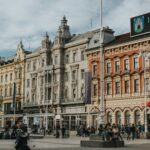A major part of the exhibition is dedicated to Croatia.
Boris Magaš, Vjenceslav Richter, Bogdan Bogdanović, Juraj Neidhardt, Milica Šterić and Svetlana Kana Radević are just some of the architects whose works will be presented at a large exhibition in New York’s MoMA, which for the first time will provide the global audience a comprehensive insight into the architecture of the former Yugoslavia, reports tportal.hr on July 15, 2018.
Under the title “Towards a Concrete Utopia: Architecture in Yugoslavia, 1948-1980”, the Museum of Modern Art in New York will today officially open the exhibition that deals with a broad topic of Yugoslav architecture and urbanization, with technology use in everyday life, consumerism and the heritage of the former state.
The authors of the exhibition are Martino Stierli, MoMA’s architectural and design curator, and Vladimir Kulić, a professor of architecture at the Florida Atlantic University. One of their Croatian collaborators is Maroje Mrduljaš, a theoretician of architecture.
“Toward a Concrete Utopia” focuses on the period of intensive construction from 1948 to Tito’s death in 1980. It includes more than 400 drawings, models, photos and videos organized in four sections. “Modernization” explores the role of architecture in the rapid urbanization and industrialization of the country, while the “Global Networks” segment is concerned with the role of Yugoslav foreign policy in shaping the state’s tourist infrastructure and building large residential and commercial projects at home and abroad.
“Everyday Life” explores residential architecture projects and the development of modern design in the socialist consumerism culture. This section includes a range of everyday objects and furniture. The final segment of the exhibition, “Identities”, deals with the relationship between Yugoslavia’s regional diversity and the aspirations for its unity.
“The Yugoslav political experiment has eventually collapsed, but the structures that can be seen here – the evidence of its aspirations and achievements – demonstrate the potential of architecture for social engagement and transformation in ways that are still relevant today,” said the exhibition authors.
“Architecture in Yugoslavia has shaped the ideals of the state and its utopian goals: accessible dwellings for citizens, new civic and social institutions, public spaces, tourist facilities, and monuments – all have become a field for experimentation. Socialism in Yugoslavia differed from that in Soviet bloc countries. Workers’ self-management was an alternative to western capitalism and the Soviet-style economy, and the country also emphasised its specific position in the world divided by the Cold War. This position was ‘the third way’ between the capitalist West and the socialist East through the Non-Aligned Movement established in 1961, in which Yugoslavia was one of the leading countries,” the authors explain.
“Toward a Concrete Utopia” at MoMa is open until January 13, 2019.
Translated from tportal.hr (reported by Tina Barbarić)









